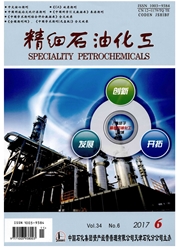

 中文摘要:
中文摘要:
实验以NH3对USY分子筛进行改性,以X射线衍射、N2吸附一脱附、固体核磁共振和氨程序升温脱附等方法对改性前后的USY分子筛进行表征。考察了NH3改性对USY分子筛的孔结构、酸性以及催化二异丙苯烷基转移反应性能的影响。结果表明,NH3改性可在保持USY分子筛骨架结构的同时,有效地改善四配位骨架铝的畸变环境。改性后的USY分子筛的BET比表面积增大,介孔孔容增加。改性产生的二次介孔改善了反应物的扩散性能。催化剂性能评价表明,当反应温度为180℃,反应压力为3MPa,质量空速为12h^-1,n(苯):n(二异丙苯)=6:1时,经NH3改性6h的USY分子筛的催化性能最佳,其催化二异丙苯烷基转移反应的转化率由67.37%升至81.51%,三异丙苯含量由0.0264%降至0.0165%。
 英文摘要:
英文摘要:
USY zeolite was modified by NH3. The USY samples before and after NH3 modification were characterized by X-ray diffraction, N2 adsorption-desorption, solid state NMR, and NH3 temperature-programmed desorption. The effects of NHa modification on the structure, acidity, and catalytic performance of USY zeolite in the transalkylation of diisopropylbenzene were investigated. The re- sults showed that NHa modification could maintain the USY zeolite framework structure, and at the same time, effectively improve the distortion environment of four-coordinated framework aluminum, which resulted in promoting the crystallinity of the USY zeolite. With the extension of NH3 modification time, mesopore volume and specific surface areas of USY zeolite increased. Furthermore, the additional mesopores generated by NH3 modification process improved the diffusion of the reactants and products. The USY zeolite modified by NH3 for 6 h had the maximum acidity and the best catalytic performance, which increased the conversion of diisopropylbenzene by nearly 10%, and significantly improved the selectivity of the reaction, decreasing the content of triisopropylbenzene from 0. 026 4 to 0. 016 5%.
 同期刊论文项目
同期刊论文项目
 同项目期刊论文
同项目期刊论文
 Comprehensive Simulation of an Intensified Process for H-2 Production from Steam Gasification of Bio
Comprehensive Simulation of an Intensified Process for H-2 Production from Steam Gasification of Bio Kinetics of Coke Formation on a Fe-ZSM-5 Zeolite Catalyst in the One-Step Oxidation of Benzene to Ph
Kinetics of Coke Formation on a Fe-ZSM-5 Zeolite Catalyst in the One-Step Oxidation of Benzene to Ph Synthesis of UZM-5 Zeolite by a Hydrothermal Method Using Tetraethylammonium Hydroxide-Tetramethylam
Synthesis of UZM-5 Zeolite by a Hydrothermal Method Using Tetraethylammonium Hydroxide-Tetramethylam The effect of different active sites on the catalytic activity of Fe-ZSM-5 zeolite for N2O direct de
The effect of different active sites on the catalytic activity of Fe-ZSM-5 zeolite for N2O direct de Predictive molecular thermodynamic models for liquid solvents, solid salts, polymers, and ionic liqu
Predictive molecular thermodynamic models for liquid solvents, solid salts, polymers, and ionic liqu Role of Structural Deficiency of Nanoscaled Perovskites Prepared by Reactive Grinding on the Catalyt
Role of Structural Deficiency of Nanoscaled Perovskites Prepared by Reactive Grinding on the Catalyt Computer Simulation of the Epitaxy of Surfactant-Templated Inorganic Nanomaterials on Patterned Surf
Computer Simulation of the Epitaxy of Surfactant-Templated Inorganic Nanomaterials on Patterned Surf The Influence of O-2, Hydrocarbons, CO, H-2, NO (x) , SO2, and Water Vapor Molecules on Soot Combust
The Influence of O-2, Hydrocarbons, CO, H-2, NO (x) , SO2, and Water Vapor Molecules on Soot Combust Effect of Organic Auxiliary Chemical-Glycerin on the Morphology Properties and Catalytic Performance
Effect of Organic Auxiliary Chemical-Glycerin on the Morphology Properties and Catalytic Performance COSMO-RS modeling on the extraction of stimulant drugs from urine sample by the double actions of su
COSMO-RS modeling on the extraction of stimulant drugs from urine sample by the double actions of su Surfactant adsorption on solid surfaces: Recognition between heterogeneous surfaces and adsorbed sur
Surfactant adsorption on solid surfaces: Recognition between heterogeneous surfaces and adsorbed sur Extraction of aromatic hydrocarbons from aromatic/aliphatic mixtures using chloroaluminate room-temp
Extraction of aromatic hydrocarbons from aromatic/aliphatic mixtures using chloroaluminate room-temp 期刊信息
期刊信息
